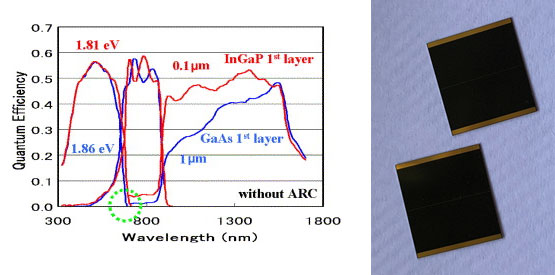Due to the double heterostructure broadband gap tunnel junction, InGaP Ge heterostructure bottom cell and the addition of indium in the traditional GaAs layer, the InGaAs intermediate cell matches the precise lattice of Ge substrate. For concentrator applications, a grid structure has been designed to reduce the energy loss caused by series resistance, and an efficiency of 37.4% (am1.5g, 200 sun) has been fabricated. In addition, due to the development of high-efficiency InGaP / InGaAs / Ge 3 -, it also shows a high efficiency and large area (7000 cm2) with an outdoor efficiency of 27% Concentrator InGaP / InGaAs / Ge 3-junction solar cell module. Junction cell, low light loss Fresnel lens and homogenizer, and design high thermal conductivity module.

In addition to the first generation crystalline silicon solar cells and the second generation thin film solar cells, the concentrator III-V compound MJ solar cells as the third generation solar cells. Develop a low-cost and high-power concentrator MJ solar cell module with an output power of 400 W / m2 for ground applications.
The six junction III-V solar cell has a conversion efficiency of 39.2% under 1-sun illumination intensity and 47.1% under 143 suns illumination intensity. The cell consists of six photosensitive layers made of III – V semiconductor alloy, each of which can capture light from a specific part of the solar spectrum. The researchers said that although the various materials of the cell add up to about 140 layers, it is actually only one-third of the thickness of human hair. The report also shows that if the series resistance is further reduced in the structure, the actual efficiency can even exceed 50%. To develop this multi junction cell, it is very difficult to minimize the atomic arrangement dislocations in the lattice mismatched III-V alloy, prevent the phase segregation in the metastable III-V alloy, and understand the diffusion of dopants in complex structures.
In June last year, NREL researchers also cooperated with scientists from the Korean Institute of advanced science and technology to develop a method to produce gallium arsenide (GaAs) solar cells using reusable germanium substrates. In the past, NREL cooperated with Chicago based microlink devices to produce three junction cells, with a record conversion efficiency of 37.75%.
III-V compounds are compounds formed by group III B, Al, GA, in and group V n, P, as and Sb in the periodic table of elements, mainly including gallium arsenide (GaAs), indium phosphide (INP) and gallium nitride.
So far, the cost of producing solar cells based on III-V compounds remains high. Therefore, these lightweight and efficient materials are often used in high cutting-edge fields such as UAVs and satellites. Further reducing the cost of such technologies has become the most urgent problem.